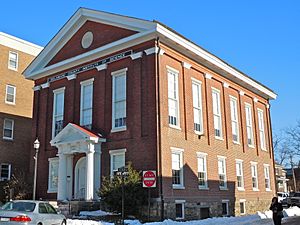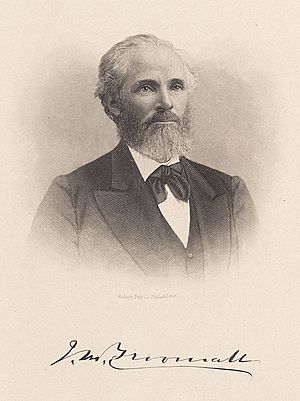Delaware County Institute of Science facts for kids
 |
|
| Established | 1833 |
|---|---|
| Location | 11 Veterans Square, Media, Pennsylvania |
| Type | Science and natural history museum |
The Delaware County Institute of Science is a cool place in Media, Pennsylvania. It's a museum about science and nature, a library, and a learning center all in one! It started way back in 1833. Inside, you can see amazing exhibits. These include mounted animals and birds, plus fossils, shells, and corals from all over the world. There's also a special collection of dried plants called an herbarium, lots of minerals, and a library for research. They even have a hall where scientists give talks!
Contents
History of the Institute
The Delaware County Institute of Science began in the summer of 1833. Five friends met at a public house in Nether Providence, Pennsylvania. They wanted to create a science group called the "Cabinet of Natural Sciences of Delaware County." These five friends were George Miller, John Miller, Minshall Painter, George Smith, and the well-known bird expert John Cassin. On September 21, 1833, they met again and officially formed the organization. They named it the Delaware County Institute of Science.
Building a Home for Science
On January 4, 1837, the Institute bought a piece of land. It was located near the Old Rose Tree Tavern in Upper Providence, Pennsylvania. Soon after, a two-story brick building was built there. The number of members in the Institute kept growing. The group officially became a corporation on February 8, 1836. The new building officially opened in September 1837. Robert Maskell Patterson, who was the director of the U.S. Mint in Philadelphia, gave a special speech at the opening.
Public Exhibitions and Growth
From September 10 to 12, 1846, the Institute held its first public show. This event displayed farm products, manufactured goods, and other items from Delaware County. The exhibition took place at their hall in Upper Providence. This public show continued every year for several years. However, in 1855, the Delaware County Agricultural Society was formed. This new group then took over the annual exhibitions.
In 1867, the Institute moved to its current building in Media, Pennsylvania. This building was first planned to have two parts. The Media Title and Trust Company was supposed to be on the first floor. The Institute was going to be on the second floor. But today, the Institute uses the entire building. Other important people connected to the Institute include the archeologist Daniel Garrison Brinton and the botanist Graceanna Lewis.
Leaders of the Institute
Many people have served as president of the Institute over the years. Here are some of them:
- George Smith, M.D. (1833–1882)
- Honorable John M. Broomall (1882–1894)
- T. Chalkley Palmer (1894–1934)
- George Pennock (1934–1938)
- Carolus Broomall (1938–1939)
- Walter Palmer (1939–1953)
- Harold W. Arndt (1953–1960)
- Russell J. Emmons (1960–1963)
- William Blake Gibson, M.D. (1963–1990)
- Alfred C. Palmer (1990–2012)
It's interesting to note that at least six of the past presidents passed away while still in office. Walter Palmer was the son of T. Chalkley Palmer.
What You Can See: Exhibits
The Institute has many cool things to see. You can find exhibits of mounted animals and birds. There are also fossils, shells, and corals from all over the world. They have an herbarium, which is a collection of dried plants. Plus, there's a large collection of minerals. The Institute also has a lecture hall where scientists give presentations about different topics.
One special item they have is a rare microscope. It was designed by Joseph Zentmayer. This microscope was even shown at the 1876 Centennial Exposition in Philadelphia. That was a huge world's fair!
The Institute's Library
The library at the Institute is a special collection. You can't check out books, but you can read them there for research. It has thousands of books and publications about natural sciences. It also has a big collection of books about the history of the local area and Pennsylvania.
See also



